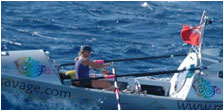|
Rowing Solo Across the Pacific!
 |
| Roz Savage rowing solo across the ocean. |
Can you imagine rowing across an ocean alone? Roz Savage can. She spent 103 days in a solo row across the Atlantic during the winter of 2005/2006. Now she plans a three-stage row across the Pacific through several national marine sanctuaries, alone and unaccompanied.
We often think of an Earth with five separate oceans: the Pacific, Atlantic, Arctic, Indian, and Southern. From nature’s perspective, however, there is really only one interconnected ocean. Ms. Savage’s voyage across the Pacific is an opportunity to better understand these connections and how human activities affect ocean health.
Departing from San Francisco and arriving in Oahu about 70 days later, her route will connect national marine sanctuaries on both sides of the Pacific. Beyond San Francisco’s Golden Gate lie three special places — Gulf of the Farallones, Cordell Bank, and Monterey Bay national marine sanctuaries — that contain some of the Pacific Ocean’s unique biological “hot spots.” Arriving in Hawaii, she will experience the awe-inspiring Hawaiian Islands Humpback Whale National Marine Sanctuary, the winter home for thousands of humpback whales that use the warm, sheltered waters for breeding and calving.
Savage will literally carry a message in a bottle from California to Hawaii. A vintage NOAA Coast and Geodetic Survey drift bottle containing a message of ocean conservation will be tucked inside Savage’s 23-foot carbon fiber boat for the journey across the Pacific. During her row, Savage will face many dangers from an ocean that will test her mental and physical abilities. You can become acquainted with the some of the seabirds, marine mammals and sharks for which it's famous on the first leg of her journey by visiting the Encyclopedia of the Sanctuaries.
Beyond nature’s challenges, Savage will unfortunately also witness firsthand the impact of human activities on the ocean. Marine debris is likely to be the most visible evidence of that impact. Drifting across the Pacific, marine debris lands on the shores of sanctuaries in California and Hawaii, a constant reminder that our everyday choices affect the ocean’s health. We can each take action to inform ourselves about the oceans and protect and conserve the natural communities they support.
You can follow her journey by viewing daily updates on her web site.
|



